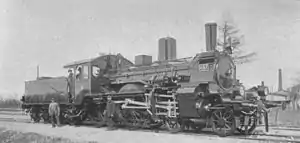| Prussian S 4 DRG Class 13.5, 13.4 | |||||||||||||||||||||||||||||||||||||||||||||||||||||
|---|---|---|---|---|---|---|---|---|---|---|---|---|---|---|---|---|---|---|---|---|---|---|---|---|---|---|---|---|---|---|---|---|---|---|---|---|---|---|---|---|---|---|---|---|---|---|---|---|---|---|---|---|---|
 | |||||||||||||||||||||||||||||||||||||||||||||||||||||
| |||||||||||||||||||||||||||||||||||||||||||||||||||||
| |||||||||||||||||||||||||||||||||||||||||||||||||||||
| |||||||||||||||||||||||||||||||||||||||||||||||||||||
| |||||||||||||||||||||||||||||||||||||||||||||||||||||
| Data for production series | |||||||||||||||||||||||||||||||||||||||||||||||||||||
The Prussian S 4's were German superheated express steam locomotives with the Prussian state railways, later grouped as DRG Class 13.5 in the Deutsche Reichsbahn. They were an evolutionary development of the Prussian S 3. The first locomotive was built in 1898 by Vulcan, Stettin as a modified S 3. She was the first superheated locomotive in the world.[1] She was initially designated as Hannover 74 and towards the end as the S 4 Cassel 401. Two further trials locomotives appeared in 1899 and 1900 as Hannover 86 and Berlin 74 also classed as S 3's. They were later reclassified as S 4's Hannover 401 and Posen 401.[1]
Not until the teething troubles had been resolved was the S 4 put into series production in 1902 in Borsig, from 1906 also in Henschel and Humboldt.[1] Unlike the prototypes the production engines were developed independently of the S 3, and 104 examples were built in the years to 1909 when procurement was halted in favour of the Prussian S 6. Up to 1906 a smokebox superheater was installed; afterwards smoke tube superheaters were used.[1]
The S 4's star waned even before the First World War, so that within a few years most of the engines had disappeared from the tracks. The remainder were employed on passenger train or even goods train duties.
In 1923 the Deutsche Reichsbahn recorded 44 S 4's in its provisional renumbering plan as 13 501-544. But by 1925 only four of them were left. These were given running numbers 13 501–504 in 1925[1] and were retired by 1927.
After the First World War, six locomotives were given to the Polish State Railways (PKP), where they were classified as Pd2 class, numbers 1 to 6.[1] During the Second World War five S 4s came into the Reichsbahn holdings from Poland as 13 401–405.[1] Two of them were eventually given back to Poland in 1955 by the DR.
The locomotives were equipped with tenders of Prussian classes pr 2’2’ T 16, pr 3 T 13 and pr 3 T 15.
See also
References
Literature
- Rauter, Herbert; Scheingraber, Günther (1991). Preußen-Report. Band 2: Die Schnellzuglokomotiven der Gattung S 1 - S 11 (in German). Hermann Merker Verlag. ISBN 3-922404-16-2.
- Weisbrod, Manfred; Müller, Hans; Petznik, Wolfgang (1976). Dampflokomotiven deutscher Eisenbahnen, Baureihe 01–39 (EFA 1.1) (in German) (3rd ed.). Düsseldorf: Alba Buchverlag. pp. 77–78. ISBN 3-87094-081-6.